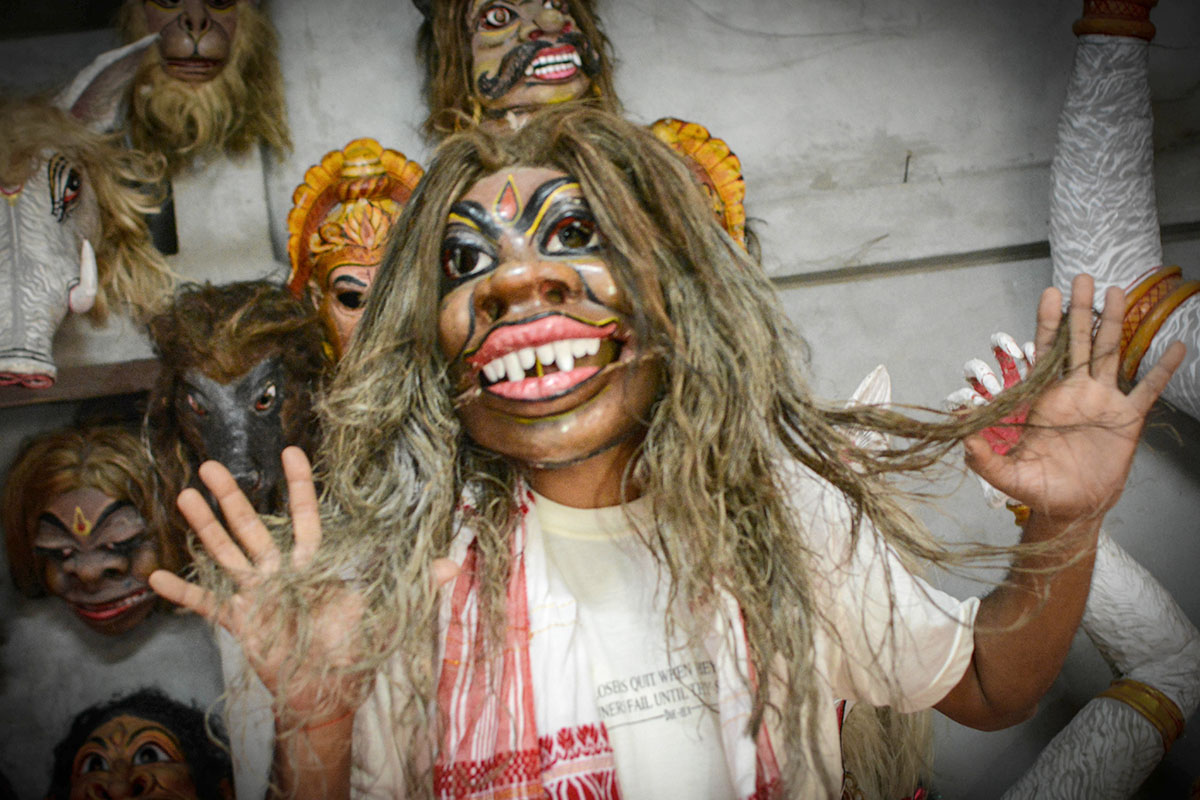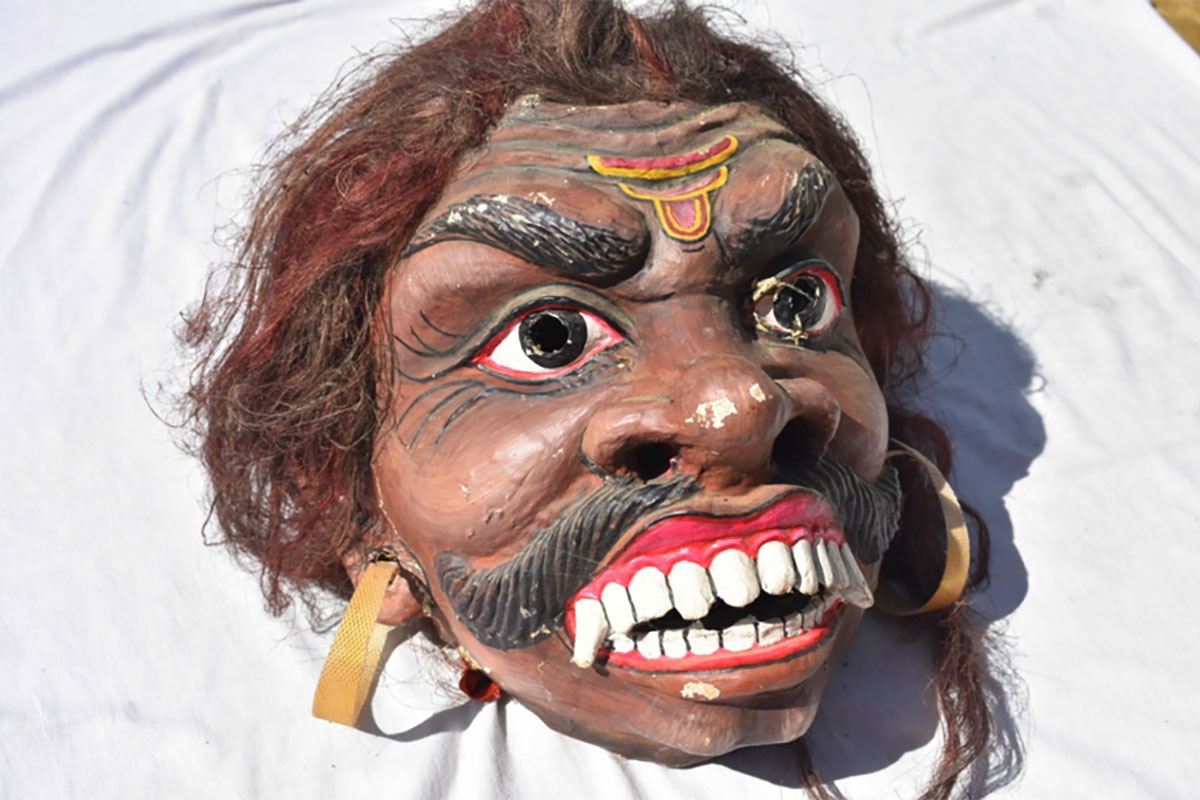ARTICLE
Bhaona Masks
Also known as mukha (face), Bhaona masks are primarily made of bamboo and wood and used in the Sattriya performative tradition of Bhaona in Assam. Representing different characters from the performative repertoire, the masks are intrinsic to the larger Sattriya tradition and considered essential for expressing rasa and bhava (emotion).
According to the Sattriya tradition, the first khanikar (mask maker) was social and cultural reformer Sankardev, who laid down the process of making traditional bamboo masks. He is said to have incorporated masks in his debut play Cinhayatra in the mid fifteenth century. However, there is evidence of wooden masks and masks made from sholapith (Indian tree-cork, Aeschynomene aspera) in the region that predate the use of bamboo. Today, mask-makers in regions such as Majuli, Assam, prepare different kinds of masks from bamboo, cane wood, fabric and earthen materials such as potter’s clay, cow dung, jute, cotton fibre, paper and natural colours, depending on the intended performative tradition.
To make the masks, a hexagonal base frame is first constructed using bamboo or sholapith, after which thin strips of cotton cloth coated with clay are plastered on the frame to form a base layer. This layer is then coated with a mixture of clay and cow dung, after which the mask is left to dry out in the sun. After the mask dries, traditionally, natural colours derived from flowers, leaves and tree bark are used to fill in details such as moustaches, eyes, eyebrows, lips and marks on the forehead. These have been replaced by the use of artificial colours. Ornamental details such as crowns, hair and jewellery are also added at this stage. Hengul (vermillion) is usually used for red, hiatal (arsenic) for yellow, dhawalmati (white clay) for white and smoke ash collected from kerosene lamps to make black. A variation on the bamboo mask is the xaasor mukha, which is made using a base frame (xaas) coated with multiple layers of cotton cloth dipped in a gum mixture of wheat, seeds from the kendu tree (Diospyros melanoxylon or Indian ebony) and hawthorn. Although it deviates from the traditional process of bamboo mask making, the xaasor mukha is lighter and more cost-effective, since the same frame can be used to make multiple masks.
Bhaona masks may feature human and animalistic elements and can be divided into two types based on the character they represent — loukik (wordly) masks, with human and animal features, and aloukik (otherworldly) masks, which depict supernatural creatures and feature exaggerated form and design. Masks are also categorised by their different sizes. Mukh or mur mukha are masks that cover only the face of the performer and are generally used for characters such as Maricha, Subahu and Surpanakha. Contrarily, bor or su mukha masks cover the entire body and are generally used for characters with supernatural or majestic characteristics, such as Ravana, Kumbhakarna, Narasimha and Narakasura. The masks are made of bamboo and are typically around 8–10 feet tall. The masks for the face and body are prepared separately and assembled during the performance. Lutukai or Suti Su mukha, used primarily during the Rasa festival, are similar to bor mukha masks, except that the head of the mask is separate from the body, allowing for comparatively easier movement; characters such as Taraka, Trishira and Shankhasur are generally portrayed wearing these masks.
Mask-making is an essential part of the Sattriya culture in Assam. However, the tradition has undergone a decline and are now infrequently included in performances. Today, bhaona masks are regularly made in the upper regions of Assam, in regions such as Jorhat, Majuli and Sivasagar.
Bibliography
Our website is currently undergoing maintenance and re-design, due to which we have had to take down some of our bibliographies. While these will be re-published shortly, you can request references for specific articles by writing to hellomapacademy@map-india.org.







![The façade of the Maneckji Seth Agiary, a Zoroastrian fire temple, is a standout example of the popularity of the Persian Revival Style in Western India in the 19th and 20th centuries. This style was often seen in the architectural patronage of the Parsis, who emerged as one of the most influential mercantile communities of British India. Popular motifs of this style, like the mythical lamasus (winged bulls with human heads) and the faravahar (a winged guardian spirit in Zoroastrianism), drew on the historical art and architecture of the Achaemenid and Sasanian empires from sites like Persepolis, Bisotun, Taq-e Bostan, Naqsh-e Rostam and Naqsh-e Rajab in Persia.
The Parsi community’s adoption of this style occurred largely due to their networks of global commerce and politics, allowing them to access and translate research of ancient Persia into visible symbols that underlined their association with antiquity, imperial power, and art.
نمای آتشکدهی زرتشتی مانِکجی سِت نمونهی بارزی از رواج سبک «احیای [معماری] ایرانی» در غرب هند طی سدههای نوزدهم و بیستم است. این سبک غالباً در بناهایی دیده میشد که پارسیان، از بانفوذترین جوامع بازرگان در هند بریتانیا، بانیشان بودند. نقشمایههای محبوب این سبک، مانند گاو بالدار اساطیری (لاماسو) و فَروَهَر (روح بالدار نگهبان در دین زرتشت)، برگرفته از هنر و معماری شاهنشاهی هخامنشی و ساسانی، در جاهایی چون تخت جمشید و بیستون و طاق بستان و نقش رستم و نقش رجب، بود.
اقتباس جامعهی پارسیان از این سبک بسیار مرهون روابط گستردهی تجاری و سیاسی آنها بود که دسترس به پژوهشها دربارهی ایران باستان و برگردانیدن آنها به نمادهای بصری را ممکن میکرد و بر پیوند پارسیان با دوران باستان و قدرت شاهنشاهی و هنر تأکید میکرد.](https://mapacademy.io/wp-content/plugins/instagram-feed/img/placeholder.png)
